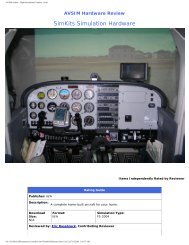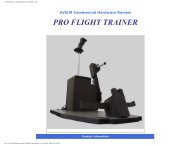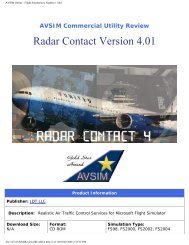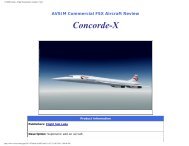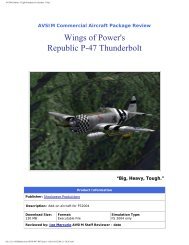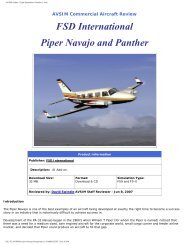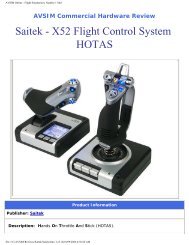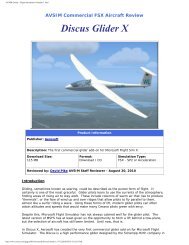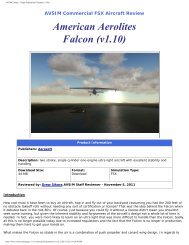You also want an ePaper? Increase the reach of your titles
YUMPU automatically turns print PDFs into web optimized ePapers that Google loves.
AVSIM Online - Flight Simulation's Number 1 Site!<br />
The Cessna <strong>T37</strong> is a basic tandem USAF trainer that entered service in 1956 with the <strong>T37</strong>-A-model. It had a twin engine<br />
layout of two Continental-Teledyne J-69-T-9 turbojet engines with 4.1 kN (420 kgp / 920 lbf) thrust each and weighed<br />
roughly 7000 pounds. Cadet training began in 1957 and the aircraft quickly gathered a reputation of being a pleasure to fly<br />
for both students and instructors. Furthermore, the plane was capable of performing all sorts of aerobatics. With regards to<br />
this, it was considered as a replacement for the F-100 Sabres of the Thunderbirds demonstration team, a proposal that was<br />
later turned down by the USAF who decided to stay with the F-100.<br />
The “Tweet” was also known as the “Dragonfly” performing in the “Combat Dragon” evaluation program where it saw CAS,<br />
FAC and night interdiction missions in South East Asia in 1967. Though underpowered and of low endurance (the aircraft was<br />
flown routineously on one engine in cruise flight), its combat appearance was regarded as a success. Improvements of the<br />
final combat “A” (attack) Version, the A37-B, affected the engines (now General Electric J85-GE-17A with 12.7 kN (1.300<br />
kgp/2850 lbf) thrust each), redundant control lines, ejection seat armour plates and self sealing tanks. The planes were also<br />
equipped with a mid-air refuelling probe. A General Electric GAU-2B/A 7.62 millimeter Gatling "Minigun" with a rate of fire of<br />
3,000 rounds a minute and 1,500 rounds of ammunition was fitted to the right side of the nose with a corresponding gun<br />
sight and camera. The avionics suite was also upgraded for battlefield communications.<br />
Microsim’s <strong>T37</strong> features the “T” (training) variants 37A and the 37C.<br />
Installation and Documentation<br />
Test System<br />
Intel Core2 Duo 6300 @<br />
1.86 GHz<br />
2 GB Ram<br />
NVidia Geforce 6600 GT<br />
Sansun PCI SN-SD6C<br />
Soundcard<br />
Track IR 3 with Vector Set<br />
Saitek X52 Joystick and<br />
Throttle<br />
CH Products Rudder Pedals<br />
Flying Time:<br />
20 hours<br />
The installer is a 73 MB file with the Flight One purchasing system. As usual with Flight One,<br />
everything worked flawless. There are two updates available, but due to piracy, their links<br />
have been removed from the homepage and you have to mail the support people personally<br />
for their direct links. I received my support mail within 12 hours of contacting Microsim. The<br />
1.03 update is 3 MB, the 1.04 update 32 MB. Once installed, you are required to change the<br />
key mapping of the speed brake and you are presented with a little configuration utility<br />
which enables you to select a soundset. A dual aircraft installation into FS 2004 is possible.<br />
The accompanying HTML-manual is simply awesome. It gives you a good insight on virtually<br />
any aspect of the plane. The electric and hydraulic system is explained, every instrument is<br />
outlined with regards to the effects of a DC or hydraulic failure. You’ll become introduced to<br />
a couple of air force procedures and you’ll receive a lesson in aerobatics. Add to all that<br />
checklists, IFR rules of thumb and speed tables, as well as an historical chapter on the<br />
evolution of the plane. The manual is a true work of dedication.<br />
I’d recommend everyone who’s unsure about purchasing the aircraft to download the .pdf<br />
manual and read a few chapters. I am convinced that after a while you’ll come to the<br />
conclusion that people who put so much compassion into a manual cannot fail to create a<br />
sound plane.<br />
If the simulation should differ in one aspect or another from the original plane, the reasons for this are explained in the<br />
manual and the difference is outlined. Most of the time, this is due to things you cannot perform in FS9 (like a preflight walk<br />
around or UHF radio etc.), sometimes it is due to convenience for the pilot (like the mini NAV panel or the autopilot<br />
supplied).<br />
Exterior Models<br />
The aircraft comes with 11 liveries. The <strong>T37</strong>A has got the Vance AFB, Reese AFB, Laughlin AFB, Columbus AFB, Sheppard<br />
AFB, Randolph AFB, Korean AF, NASA and Cessna factory rollout paint schemes. The <strong>T37</strong>C (armaments trainer) of the 1.04<br />
update, with its long range wingtip tanks, has a camouflage scheme. All textures are photorealistic with readable decals.<br />
Some are highly reflective with impressive effects as outlined in the screenshots.<br />
file:///C|/AVSIM/Reviews/<strong>T37</strong>/<strong>T37</strong>.htm (2 of 7)13/04/2007 7:18:21 PM



